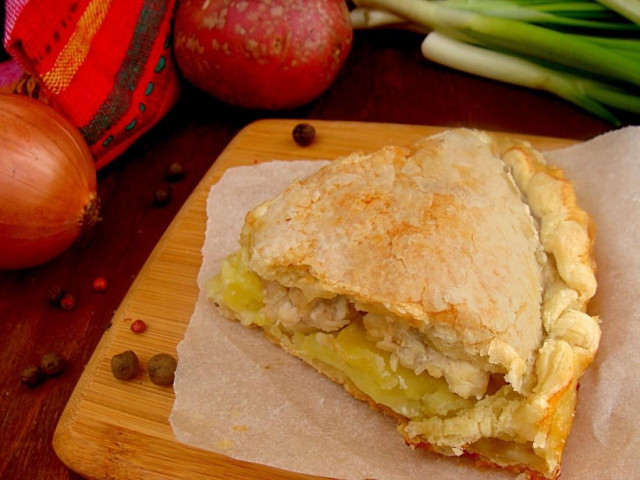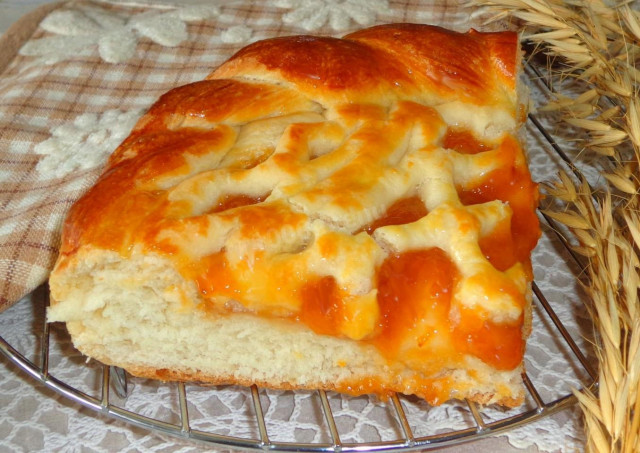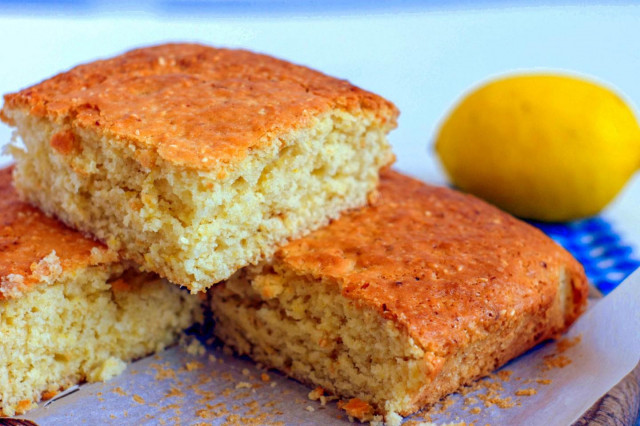Composition / ingredients
Step-by-step cooking
Step 1:
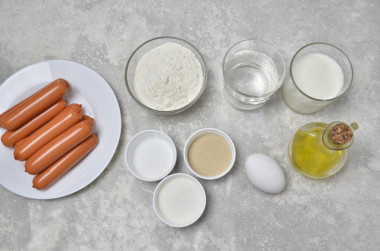
How to make sausages in yeast dough on kefir in the oven? Prepare the products. Kefir is suitable for any fat content, refined oil, odorless. I indicated the sausages in grams, focus on the number of about 16 pieces.
Step 2:
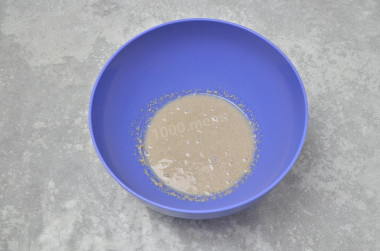
Heat the water to a temperature of ~ 38 ° C — it should feel pleasantly warm, but not hot. Pour it into a large bowl in which you will knead the dough. Add sugar and yeast, mix. Leave it on the table for 15 minutes.
Step 3:
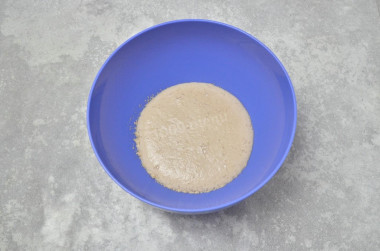
During this time, the yeast should be activated — rise with a cap on the surface. If this did not happen, then you will have to take others. Why is water temperature important? Yeast is a living organism, too hot water will kill them, they won't wake up in cold water.
Step 4:
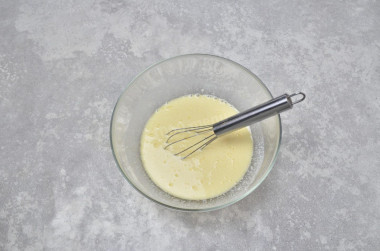
Pour warm kefir into a separate bowl. You can warm it up a little in the microwave or in a water bath. Do not overdo it so that the cottage cheese does not turn out. Add the egg and salt to the kefir, mix everything with a whisk. Be sure to wash the eggs before use, as even the seemingly clean shell may contain harmful bacteria. It is best to use food detergents and a brush.
Step 5:
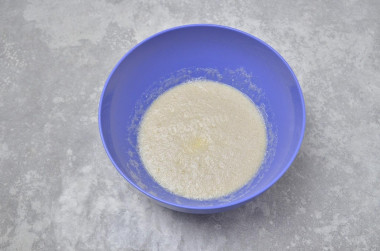
Pour the kefir mixture to the yeast mixture, stir.
Step 6:
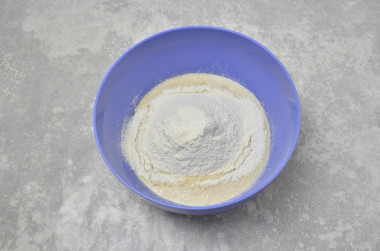
Start sifting the flour in portions, kneading the dough after each addition. At first it will be convenient to stir with a fork, then start kneading with your hands. Be prepared for the fact that the flour may go more or less than specified in the recipe — look at the test. It should become smooth, elastic, but at the same time remain soft.
Step 7:
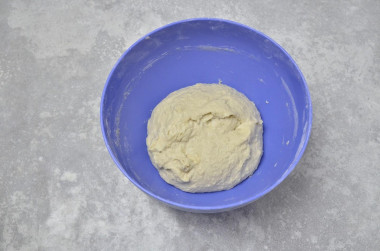
At the end, pour vegetable oil into the dough. Mix it into the dough, it will practically stop sticking to your hands and begin to lag behind the walls. As soon as this happens, stop kneading. Assemble the dough into a ball, cover the bowl with a lid, towel or film and put it away for 1.5 hours in a warm place without drafts for lifting. I usually put it in the oven, not working!!!
Step 8:
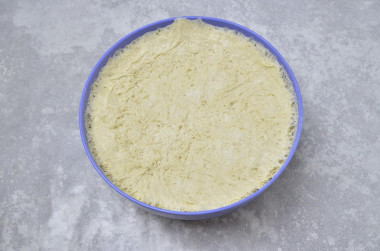
After the specified time, the dough will greatly increase in volume, I even started to "run away" from the bowl. Knead it — it will become smaller again and leave it to stand on the table for another 10 minutes. The dough turns out to be quite a large amount, so it will be more convenient to work with its halves.
Step 9:
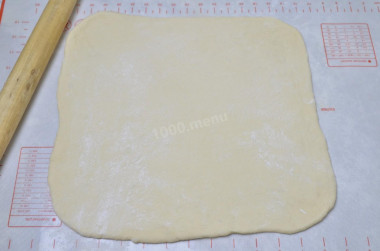
Then put the dough on a floured surface and roll it out with a rolling pin into a rectangular layer 1.5 cm thick .
Step 10:
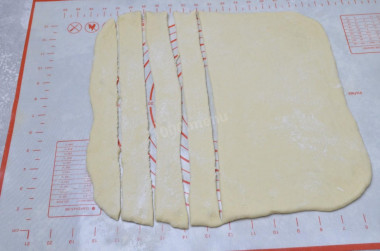
Cut the resulting layer into strips 2cm wide. I made it with a spatula, it is also convenient to cut it with a pizza knife.
Step 11:
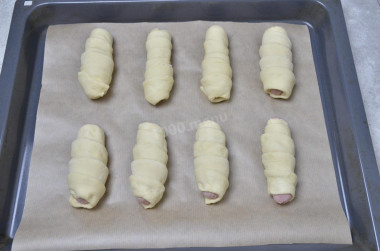
Peel the sausages from the film. Wrap each sausage with a strip of dough, winding it in a spiral. Place the sausages on a baking sheet lined with baking paper. Leave a place between them — the yeast dough will greatly increase in size.
Step 12:
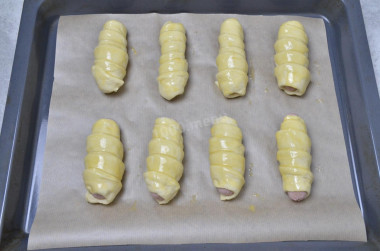
Beat the yolk with a fork. Brush the dough with it on top with a cooking brush.
Step 13:
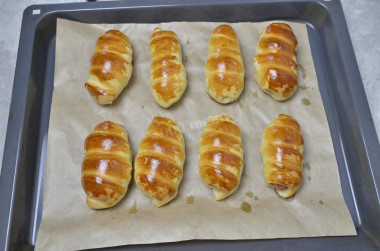
Bake the sausages in an oven preheated to 200 °C for 20-25 minutes. The exact time will depend on the characteristics of your oven. The dough should be browned on top.
Step 14:

Cool the finished sausages a little and serve them to the table — they are delicious in a warm form. You can supplement them with sauces to taste. Bon appetit!
It is important to sift the flour to saturate it with oxygen. Then the baking will turn out to be airy and will rise well when baking.
Keep in mind that everyone's ovens are different. The temperature and cooking time may differ from those specified in the recipe. To make any baked dish successful, use useful information about the features of ovens !
Important! Using dry yeast, it should be borne in mind that they occur in two forms: active and instant (read the instructions carefully before use!).
Active dry yeast looks like beads or small balls. Before applying them, they must be brought out of the "sleep mode". To do this, the active yeast is diluted in warm sweet water, milk or whey. The resulting bubbles, foam or "cap" indicate that the yeast is ready for further use. Active dry yeast must be brought to complete dissolution in the liquid, otherwise, due to the remaining grains, the dough may not rise and the baking will be spoiled (yeast grains that have not dissolved in the liquid and got into the dough will not disperse on their own, which means they will not work).
Instant dry yeast is easier to use. They do not need to be activated before use. Such yeast, along with other ingredients, is simply added to the dough. As a result, the baking time is reduced.
It should also be remembered that both types of dry yeast may differ in their activity from different manufacturers.
Caloric content of the products possible in the composition of the dish
- Chicken egg - 157 kcal/100g
- Egg white - 45 kcal/100g
- Egg powder - 542 kcal/100g
- Egg yolk - 352 kcal/100g
- Ostrich egg - 118 kcal/100g
- Whole durum wheat flour fortified - 333 kcal/100g
- Whole durum wheat flour universal - 364 kcal/100g
- Flour krupchatka - 348 kcal/100g
- Flour - 325 kcal/100g
- Granulated sugar - 398 kcal/100g
- Sugar - 398 kcal/100g
- Kefir fat - 62 kcal/100g
- Kefir of 1% fat content - 38 kcal/100g
- Low-fat kefir - 30 kcal/100g
- Kefir "doctor beefy" 1,8% fat content - 45 kcal/100g
- Kefir 2.5% fat content - 53 kcal/100g
- Vegetable oil - 873 kcal/100g
- Salt - 0 kcal/100g
- Milk sausages - 266 kcal/100g
- Sausages "Russian" - 243 kcal/100g
- Pork sausages - 324 kcal/100g
- Canned sausages - 228 kcal/100g
- Water - 0 kcal/100g
- Egg yolks - 352 kcal/100g
- Dry yeast - 410 kcal/100g






